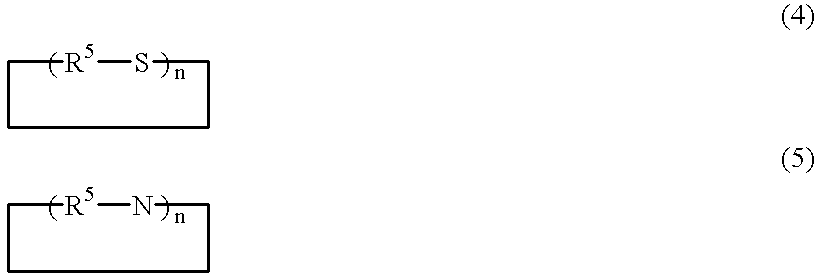Addition-curing organopolysiloxane composition
a technology of organopolysiloxane and composition, which is applied in the field of addition cureable organopolysiloxane composition, can solve the problems of lowering the reaction inhibiting effect, difficult to keep compatible curability with stability, and troublesome handling, and achieve excellent shelf stability and rapid cure by heating
- Summary
- Abstract
- Description
- Claims
- Application Information
AI Technical Summary
Benefits of technology
Problems solved by technology
Method used
Image
Examples
examples 6-11
100 parts of dimethylpolysiloxane having a molecular weight of about 60000 and a molecular chain, both ends of which were hindered with dimethylvinylsilyl groups, and 1 part of dimethylpolysiloxane having a molecular weight of about 2000 and a molecular chain, both ends of which were hindered with dimethylhydrogensilyl groups, were thoroughly stirred to prepare a base resin.
A platinum catalyst was prepared according to the following procedure: To two-necked flask equipped with a dropping funnel containing about 0.16 g (ca. 0.02 mole) of tert-butyl isocyanide were added about 0.42 g (ca. 0.01 mole) of potassium chloroplatinate and 1 molar % tetrabutylammonium chloride, the reaction system was thoroughly filled with nitrogen gas and then the content was dissolved in 5 ml of pure water. After confirming the dissolution of the reaction substrate in the reaction system, the isocyanide compound placed in the dropping funnel was slowly added dropwise at room temperature. Thereafter, the mi...
examples 12-17
TABLE 2 Photo- Gelling Curing Shelf curing Reaction rate initiation stability property inhibitor (%) temp. (.degree. C.) (h) (%) Ex. 6 t-Butyl 80.5 83.2 168 100.0 isocyanide Ex. 7 Cyclohexyl 100.0 77.4 96 100.0 isocyanide Ex. 8 Phenyl 100.0 82.1 72 45.0 isocyanide Ex. 9 Benzyl 50.5 74.8 48 55.0 isocyanide Ex. 10 4-Chloro-phenyl 100.0 81.3 24 65.3 isocyanide Ex. 11 4-Methoxy-phenyl 95.5 85.6 96 74.6 isocyanide Comp. 3-Methyl-1-buten- 100.0 45.4 1 0 Ex. 1 3-ol Comp. Tetramethyl- 100.0 55.9 1 0 Ex. 2 ethylenediamine Comp. Phenyl 9.8 110.0 240 0 Ex. 3 isothiocyanate
100 parts of dimethylpolysiloxane having a molecular weight of about 60000 and a molecular chain, both ends of which were hindered with dimethylvinylsilyl groups, and 1 part of dimethylpolysiloxane having a molecular weight of about 2000 and a molecular chain, both ends of which were hindered with dimethylhydrogensilyl groups, were thoroughly stirred to prepare a base resin. To this base resin was added an isopropanol solutio...
examples 18-23
100 parts of dimethylpolysiloxane having a molecular weight of about 60000 and a molecular chain, both ends of which were hindered with dimethylvinylsilyl groups, and 1 part of polydimethylpolysiloxane having a molecular weight of about 2000 and a molecular chain, both ends of which were hindered with dimethylhydrogensilyl groups, were thoroughly stirred to prepare a base resin. Then, to an isopropanol solution of chloroplatinic acid-hexahydrate containing 2.0% platinum was added the imino compound shown in Table 4 to prepare a platinum-imino complex. Amounts of the imine Compounds to be blended were 2 equivalents in Example 18 and Comparative Example 5, 1 equivalent in Example 19, 3 equivalents in Example 20 and Comparative Example 6 and 4, equivalent in Example 21, respectively, to platinum atom. Thereafter, to the base resin previously prepared was added the platinum complex at 30 ppm to afford the desired resin compositions.
PUM
| Property | Measurement | Unit |
|---|---|---|
| Temperature | aaaaa | aaaaa |
| Temperature | aaaaa | aaaaa |
| Temperature | aaaaa | aaaaa |
Abstract
Description
Claims
Application Information
 Login to View More
Login to View More - R&D
- Intellectual Property
- Life Sciences
- Materials
- Tech Scout
- Unparalleled Data Quality
- Higher Quality Content
- 60% Fewer Hallucinations
Browse by: Latest US Patents, China's latest patents, Technical Efficacy Thesaurus, Application Domain, Technology Topic, Popular Technical Reports.
© 2025 PatSnap. All rights reserved.Legal|Privacy policy|Modern Slavery Act Transparency Statement|Sitemap|About US| Contact US: help@patsnap.com



